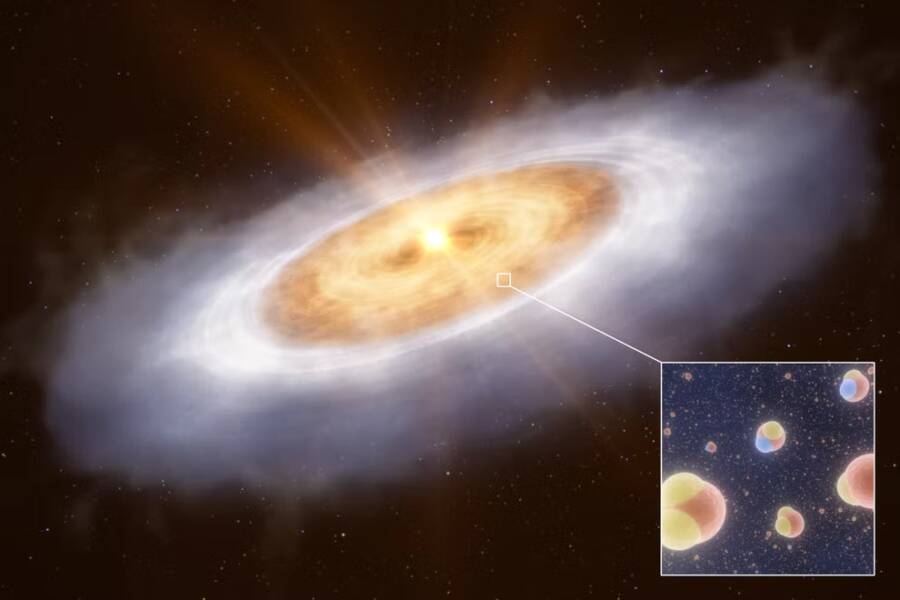Researchers suggest the water molecules could provide insight into the "missing link" that explains the origins of water on Earth.

European Southern ObservatoryAn artist’s impression of the planet-forming disk around V883 Orionis.
Astronomers studying a remote star in the Orion constellation observed gaseous water molecules with a chemical composition stunningly similar to water found in comets near Earth. And experts think this star can help explain how Earth first got its water billions of years ago.
“We can think of the path of water through the universe as a trail,” said study lead author John J. Tobin, an astronomer at the National Radio Astronomy Observatory, in an interview with The Independent. “We know what the endpoints look like, which are water on planets and in comets, but we wanted to trace that trail back to the origins of water. Until now, the chain of water in the development of our Solar System was broken.”
Using a powerful radio telescope, the astronomers discovered the gaseous water circling V883 Orionis, a young star about 1,300 light years away from Earth. Previously, scientists had observed the journey of water from gas clouds to young stars, and from comets to planets, but figuring out how water moved from young stars to comets had proven difficult to pin down.
Since the gaseous water around V883 Orionis is so similar to the kind found in comets near Earth, this new discovery suggests that the water delivered by comets to our planet billions of years ago originated from gas clouds — which may be older than the 4.6-billion-year-old Sun.
“V883 Orionis is the missing link in this case,” Tobin said. “The composition of the water in the disc is very similar to that of comets in our own Solar System. This is confirmation of the idea that the water in planetary systems formed billions of years ago, before the Sun, in interstellar space, and has been inherited by both comets and Earth, relatively unchanged.”
Stars are formed when massive clouds of gas and dust collapse, rapidly heating as they come together. Around the central star, matter from the cloud forms a disk, which over millions of years gradually clumps together to form comets, asteroids, and planets. The question astronomers sought to answer was this: Where did the water in our Solar System come from?
To answer this question, the team used the Atacama Large Millimeter/submillimeter Array (ALMA), an array of radio telescopes in Chile, to scan V883 Orionis for signs of radiation emitted by gaseous water — the result of molecules spinning. This becomes complicated, however, when water is frozen, as the movement of molecules is more constrained.
“Most of the water in planet-forming discs is frozen out as ice, so it’s usually hidden from our view,” said study co-author Margot Leemker, a Ph.D. student at Leiden Observatory in the Netherlands. To further complicate things, gaseous water near the center of planetary disks, where temperatures are higher, is usually obscured by the dust that makes up the disk. These warmer regions are also small and difficult to image with telescopes.

John Moore/Getty ImagesPart of the Atacama Large Millimeter/submillimeter Array (ALMA) in Chile, which astronomers used in the study.
V883 Orionis, however, was recently found to be atypically hot, “up to a temperature where water is no longer in the form of ice, but gas, enabling us to detect it,” Tobin said — making it a perfect candidate for observation. Using ALMA, the team was able to detect water in the star’s disk, determine its composition, and map its distribution throughout the disk.
It should be noted that while the typical composition of water as we know it consists of one oxygen atom and two hydrogen atoms (H20), it is not the only way water can be composed. In fact, Tobin’s team studied a heavier version of water in which one hydrogen atom is replaced with deuterium, a heavy isotope. Simple water and heavy water form under different conditions, so by analyzing the ratio of simple to heavy water in a system, astronomers can determine when and where that water was formed.
Some of our Solar System’s comets have previously reflected a water ratio that’s similar to Earth’s water ratio, suggesting that Earth’s water could have been delivered by comets billions of years ago.
In observing V883 Orionis, Tobin’s team discovered a similar ratio dispersed throughout the young star’s disk — and found that the disk contains at least 1,200 times the amount of water in the Earth’s oceans.
“We conclude that disks directly inherit water from the star-forming cloud and this water becomes incorporated into large icy bodies, like comets, without significant chemical alteration,” astronomers wrote in the study.
“We can now trace the origins of water in our Solar System to before the formation of the Sun,” added Tobin. But the team still has plenty of work ahead of them before they can put the mystery to rest for good.
In the future, they intend to use the European Southern Observatory’s Extremely Large Telescope and its first-generation instrument Mid-infrared ELT Imager and Spectrograph to help solidify the link of water’s path from star-forming clouds to solar systems. “This will give us a much more complete view of the ice and gas in planet-forming discs,” Leemker said.
After reading about this astronomical discovery, learn about when astronomers discovered the real-life planet Vulcan from “Star Trek.” Then, check out the most detailed map of our galaxy to date.





